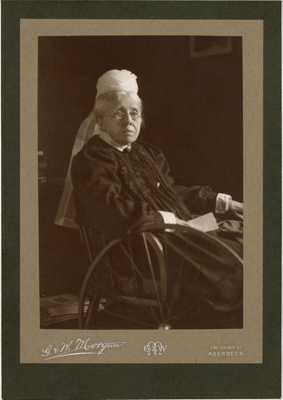Name/TitleCabinet card: Unidentified woman
About this objectCabinet card photograph of an unidentified elderly white woman with hair tied back, wearing a white cap and dark dress with wide sleeves and white cuffs and collar. The woman is seated and her right arm appears to be resting on a large wooden wheel with metal hub. The photograph is mounted on thick dark green card with a goldish border bearing the embossed name, crest and location of the photographer.
MakerG. & W. Morgan
Maker RolePhotographer
Date Madec.1890-1909
PeriodLate Victorian or Edwardian
Place MadeScotland, Aberdeen
Place NotesG. & W. Morgan
393 Union Street, Aberdeen
Medium and MaterialsOrganic, card
MeasurementsH: 183 x W: 129 mm
Subject and Association Descriptionhttps://en.wikipedia.org/wiki/Cabinet_card:
The cabinet card was a style of photograph which was widely used for photographic portraiture after 1870. It consisted of a thin photograph mounted on a card typically measuring 108 by 165 mm (4+1⁄4 by 6+1⁄2 inches).
The carte de visite was displaced by the larger cabinet card in the 1880s. In the early 1860s, both types of photographs were essentially the same in process and design. Both were most often albumen prints, the primary difference being the cabinet card was larger and usually included extensive logos and information on the reverse side of the card to advertise the photographer’s services. However, later into its popularity, other types of papers began to replace the albumen process. Despite the similarity, the cabinet card format was initially used for landscape views before it was adopted for portraiture.
Some cabinet card images from the 1890s have the appearance of a black-and-white photograph in contrast to the distinctive sepia toning notable in the albumen print process. These photographs have a neutral image tone and were most likely produced on a matte collodion, gelatin or gelatin bromide paper. Sometimes images from this period can be identified by a greenish cast. Gelatin papers were introduced in the 1870s and started gaining acceptance in the 1880s and 1890s as the gelatin bromide papers became popular. Matte collodion was used in the same period. A true black-and-white image on a cabinet card is likely to have been produced in the 1890s or after 1900. The last cabinet cards were produced in the 1920s, even as late as 1924.
Named CollectionGlasgow Women's Library
Object TypePhotograph
Object numberGWL-2022-148-16
Copyright LicenceAll rights reserved


